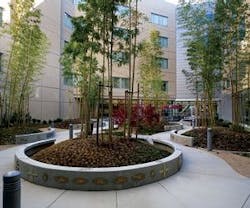Small Ways to Build Green
Buildings will have carbon footprints of zero by the year 2030 – or at least that’s the call to action for architects and building managers from the American Institute of Architects. Although this doesn’t seem possible now, there are a number of ways – new and old – to develop sustainable buildings.
- Borrow from Industry Leaders. Quicken your sustainability efforts by borrowing ideas and research from the best companies striving to be carbon neutral. Contact those companies and see what they’re doing and how you can replicate it. Gundersen Lutheran and Geisinger Health Plan® both have aggressive plans to slash their carbon footprints well before 2030.
- Look at the Past. Look back 60 years in the United States and you’ll see that the traditional hospital had a smaller footprint and caused less environmental damage; however, after the 1950s, things changed, and countries like the United States and Australia started building bigger, hermetically sealed buildings devoid of natural light and artificially heated and cooled. Some countries, such as Germany, Denmark, and the Netherlands, always provided operable windows and thin footprints. The rest of us need to consider rewiring to that model. In addition to building smaller, it’s important to build medical facilities close to where people work, live, and have access to public transportation. Designers of one German town, Vauban, built it to be car free. Residents ride bicycles and walk, which promotes physical activity and reduces air pollution and greenhouse gases. Kaiser Permanente is looking at three future hospital sites with a mixed-use approach so that care can be delivered next to housing, shopping, and mass transit.
- Sustainable Products. Lighting is one area where new products provide energy-efficient options. The next generation of LED lighting now costs less, is more reliable, and can be an option in healthcare settings. Using a combination of task lighting, LEDs, light controls, photosensors, and smaller floorplates designed with daylighting to bring in sunlight is something you can do now.
- Location Makes a Difference. Several sustainable opportunities may exist, depending on your location. If located next to a river, you might be able to use hydroelectric power. If you’re in a windy area, wind turbines could be an option. Geothermal power is cost effective, reliable, and environmentally friendly; however, it’s available only in limited areas. If your site is on or near a previous landfill with large amounts of organic material, you could capture the methane and use it as a fuel source. Photovoltaics are also an option.
- Water Conservation. Conserving water takes a combination approach. Converting from wet-process imaging equipment to digital imaging machines can save approximately 925,000 gallons of potable water per year and eliminate the use of harmful chemicals. Other small things you can do include sensor-operated faucets and dual-flush toilets. Planting drought-resistant plants and plants native to your location reduces the need for supplemental irrigation. No matter how much rainfall you get, harvesting rainwater helps as well.
- Build Universally. Build in such a way that the building is self renewable. The typical life-cycle of a building is about 30 years. A flexible and adaptable building plan permits the incorporation of new technology. Build small, build just what you need, and constantly renew building systems.
- Technology Advancements. Technology is replacing a high number of in-person visits with virtual doctor visits. Electronic medical records and providing Web capabilities are other ways to reduce carbon footprints.
- Join Others. Join groups, such as the Global Health and Safety Initiative, to work with healthcare organizations to advance environmental sustainability. Banning together can make a difference and could result in changes like new ENERGY STAR® appliances for hospitals.
John Kouletsis is executive director of strategy, planning, and design, national facilities services, at Kaiser Permanente, which is headquartered in Oakland, CA.
